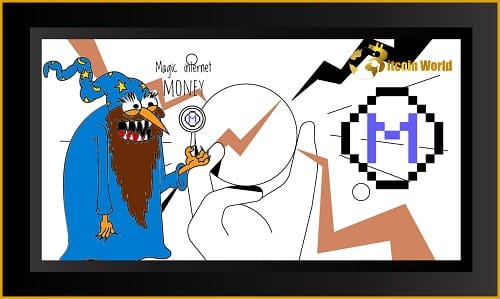The cryptocurrency world never sleeps, and lately, it’s been delivering more drama than a prime-time soap opera. The latest episode features Abracadabra’s Magic Internet Money (MIM), a stablecoin pegged to the US dollar, experiencing a significant wobble. Remember the TerraUSD (UST) implosion? Well, the tremors from that seismic event are still being felt, and some believe MIM’s recent troubles are a direct aftershock. Let’s dive into what happened and why it’s got the crypto community buzzing.
The MIM De-Pegging: What Went Down?
On June 17th, alarm bells started ringing as MIM began to lose its coveted $1 peg. The descent was swift and concerning. Starting around 7:40 p.m. ET, the price plummeted, hitting a low of $0.926 within just three hours. For a stablecoin, this kind of volatility is a red flag, raising questions about its stability and the mechanisms designed to maintain its peg.
| Event | Time (ET) | MIM Price |
|---|---|---|
| De-pegging Begins | ~7:40 PM | ~$1.00 |
| Significant Drop | ~10:40 PM | $0.926 |
Terra’s Ghost: Did the Collapse Cause a Chain Reaction?
Enter Autism Capital, a prominent voice on Crypto Twitter. They didn’t mince words, alleging a direct link between Terra’s dramatic downfall and MIM’s woes. Their argument? The collapse of LUNA and UST didn’t just hurt individual investors; it inflicted damage on various crypto projects, Abracadabra’s MIM ecosystem included.
Autism Capital further claimed that Abracadabra accumulated a staggering $12 million in bad debt as a direct consequence of Terra’s demise. The reasoning behind this claim is that the rapid market downturn prevented liquidations from happening quickly enough to cover Abracadabra’s MIM liabilities. Imagine a scenario where assets meant to back the stablecoin’s value suddenly became worth far less, leaving a significant gap.
“Insolvent? Absolutely Not!” – Abracadabra’s CEO Responds
Daniele Sestagalli, the founder of Abracadabra, vehemently refuted these claims of insolvency. He assured the community that the project possessed ample financial resources to cover any outstanding debts. In a move towards transparency, Sestagalli even shared the treasury address, revealing $12 million in assets. He encouraged concerned investors to verify this information themselves using publicly available on-chain data. This proactive approach aimed to quell fears and demonstrate the project’s financial health.
The Plot Thickens: A Disagreement on the Timeline
However, the back-and-forth didn’t end there. Autism Capital doubled down on their accusations, suggesting that Sestagalli’s acknowledgment of bad debt was more recent than he implied. They even shared a screenshot purportedly showing Sestagalli discussing this debt in MIM’s Discord channel just five days prior to the de-pegging event. This raises questions about the timing and extent of the financial challenges faced by Abracadabra.
What Does This Mean for the Crypto Market?
The situation with MIM highlights several crucial aspects of the current crypto landscape:
- Stablecoin Vulnerability: Even stablecoins, designed to be anchors in the volatile crypto sea, are not immune to market shocks. The Terra collapse served as a stark reminder of the risks involved, and MIM’s de-pegging further underscores this vulnerability.
- Interconnectedness of Crypto Projects: The crypto ecosystem is highly interconnected. The failure of one significant project can have ripple effects, impacting others in unexpected ways. The alleged link between Terra and MIM exemplifies this interconnectedness.
- Importance of Transparency: Sestagalli’s decision to share the treasury address is a positive step towards transparency, which is crucial for building trust in the often opaque world of decentralized finance (DeFi).
- The Role of Community Scrutiny: Platforms like Twitter and Discord have become important channels for community members like Autism Capital to raise concerns and scrutinize projects, holding them accountable.
Key Takeaways for Crypto Traders and Investors:
- Diversification is Key: Don’t put all your eggs in one basket, especially in a volatile market. Diversify your holdings across different asset classes.
- Do Your Own Research (DYOR): Before investing in any cryptocurrency, especially stablecoins, understand the underlying mechanisms, risks, and the team behind the project.
- Monitor Market Sentiment: Keep an eye on community discussions and news surrounding the projects you’re invested in. Platforms like Twitter and Telegram can provide valuable insights (but always verify information).
- Understand the Risks of DeFi: Decentralized Finance offers exciting opportunities but also comes with significant risks, including smart contract vulnerabilities and the potential for cascading liquidations.
Looking Ahead: Navigating the Crypto Winter
The ongoing “crypto winter” is testing the resilience of various projects. The situation with Abracadabra and MIM serves as a cautionary tale, highlighting the challenges and potential pitfalls in the decentralized finance space. While Sestagalli maintains that the project is solvent, the controversy underscores the importance of due diligence and the need for robust mechanisms to ensure the stability of stablecoins. As the crypto market continues to evolve, these events provide valuable lessons for both project developers and investors alike.
Disclaimer: The information provided is not trading advice, Bitcoinworld.co.in holds no liability for any investments made based on the information provided on this page. We strongly recommend independent research and/or consultation with a qualified professional before making any investment decisions.


